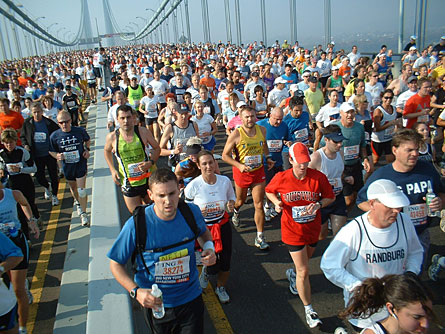Marathoners’ hearts stressed, but not necessarily by heart attacks
Detailed imaging of runners’ hearts before and after races doesn’t find signatures of heart attacks
ORLANDO, Fla. — Even though studies have found that marathoners can experience changes in heart structure and function consistent with cardiac damage, the runners aren’t necessarily having small heart attacks, a new investigation has found.

Previous studies have revealed that during a race, marathon runners often show evidence of dangerous changes to the heart, including an enlarged right atrium (the chamber that receives oxygen-starved blood from the body) and elevated levels in the blood of enzymes that signal heart damage. These studies have raised concern about the stress prolonged exercise puts on the heart.
And events during some races haven’t always been reassuring: In October, two people died during a half marathon in San Jose, another during the Baltimore Marathon and three more runners died later that same month during the Detroit Free Press/Flagstar Marathon in downtown Detroit.
But although the heart is under stress, the changes it experiences appear to be temporary and not a signal of damage, according to research presented November 18 during the American Heart Association’s Scientific Sessions 2009. To better study how the heart copes with marathon running, researchers from the William Beaumont Hospital in Royal Oak, Mich., studied 25 healthy men and women who participated in the Detroit marathon in 2008, testing the runners immediately before and after the race with imaging studies and other tests that can detect cardiac injury.
During the meeting, researcher Justin Trivax reported that the new study did find the same kinds of changes that had shown up in previous investigations: Among other things, just after the race, the heart’s right atrium had swollen, an average of about 20 percent in each runner, while the right ventricle (which pumps blood to the lungs for a fresh supply of oxygen) had enlarged about 25 percent. In addition, the volume of blood the right ventricle could squeeze out with each contraction had dropped by about 15 percent.
However, Trivax said, the runners were not having mild heart attacks. Advanced magnetic resonance imaging taken just after the runners finished their races, did not show any evidence that parts of the heart were suffering damage or lacking blood flow. In addition, levels of alarm enzymes in the blood did not ebb and flow with the patterns of an ongoing heart attack. All of the changes observed in the right side of the heart had subsided within three to six months after runners had crossed the finish line.
Nonetheless, questions remain. While the enlargements of the heart’s right chambers do not appear to cause immediate harm, Trivax said at the meeting, no one can yet say whether subtle, undetected damage may accumulate over time, predisposing certain runners to the risk of sudden death at some point in the future. However, he said, until more is understood, the known benefits of distance running appear to outweigh the theoretical risks of harm.







